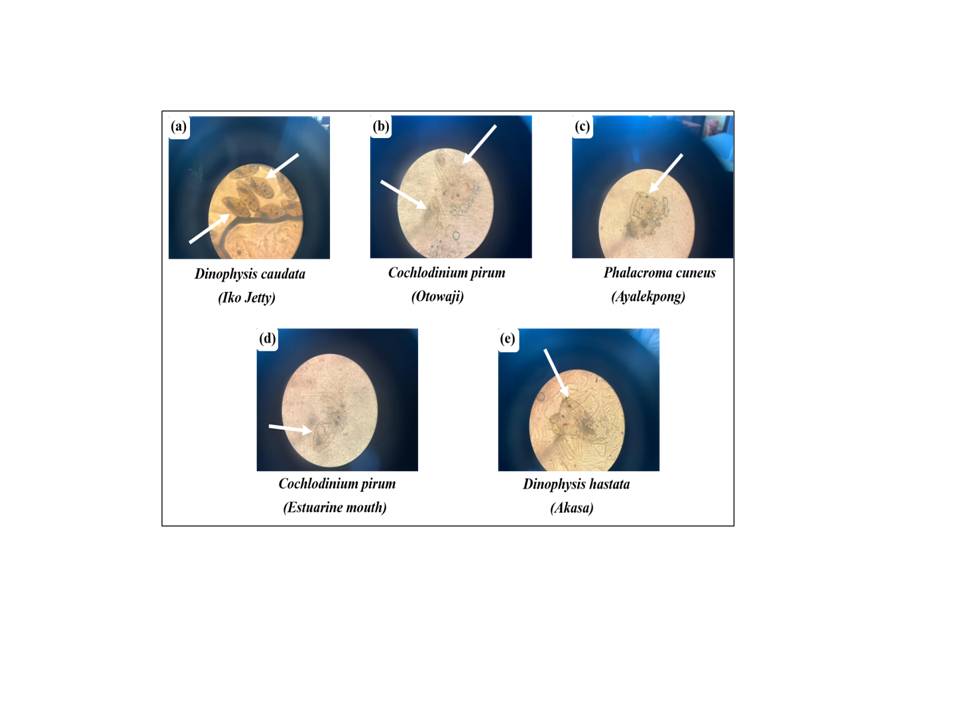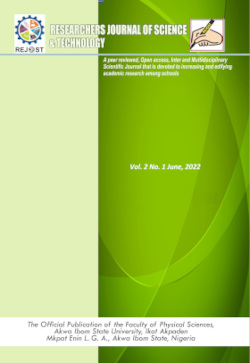Mitigation of Dinoflagellate Biofilms using Dendrobranchiata Sp. along Iko River Estuary, South Eastern Nigeria
Keywords:
Biofilm, Dinoflagellates sp., Dendrobranchiata sp., Chitosan, Iko River EstuaryAbstract
Biofilms are complex surface-attached communities of bacteria held together by self-produced polymer matrix, and primarily composed of extracellular polymeric complexes. Biofilms are known to adhere to any material surface due to the growth and adhesion of microorganisms and are a vital component in the microbial corrosion of concrete. One of the peculiar types of bacteria that produce biofilm is the Dinoflagellates sp. This study aims to adopt chitosan component derived from Dendrobranchiata sp. (Prawn) to mitigate the biofilm growth of Dendrobranchiata sp. The sampling was carried out at the Iko River Estuary, Eastern Obolo, South Eastern Nigeria. Samples were taken from 5 different stations; station 1 (Iko Jetty), station 2 (Otowaji), station 3 (Ayalekpong), station 4 (Estuarine mouth), and station 5 (Akasa). The characterization methods adopted for the study were surface morphology using a microscope, UV-spectrophotometric technique for the determination of the concentration of Dinoflagellates sp, and physicochemical parameters determination of the turbidity, salinity, temperature, pH, dissolved oxygen (DO), and conductivity. Chitosan samples obtained from Dendrobranchiata sp. (Prawn) undergo three stages of reactions; demineralization, deproteinization, and deacetylation. The surface morphology characterization showed the presence of various dinoflagellate species such as Dinophysis caudata, Cochlodinium pirum, Phalacroma cuneus, and Dinophysis hastata. A higher pH value of about 9.0 was observed at the mouth of the estuary due to the influx of seawater. The 5-day results showed an increase in the biofilm growth as observed in the concentration results in the five stations. The highest concentration value of about 0.75 mg/L was observed on day 1, and the lowest value of about 0.40 mg/L was observed on day 5. The concentration value for media with chitosan was about 0.20 mg/L, while the media with Dinoflagellates sp. had about 0.40 mg/L. The reduction could be attributed to the decrease in the availability of nutrients for bacteria growth when chitosan was applied. The mitigation approach indicates that the chitosan acted as an excellent antimicrobial agent for the mitigation of dinoflagellates sp. biofilm growth.
References
Bach, L. T., MacKinder, L. C. M., Schulz, K. G., Wheeler, G., Schroeder, D. C., Brownlee, C. & Riebesell, U. (2013). Dissecting the impact of CO2 and pH on the mechanisms of photosynthesis and calcification in the coccolithophore Emiliania huxleyi. New Phytologist, 199(1), 121–134. https://doi.org/10.1111-/NPH.12225
Battin, T. J., Kaplan, L. A., Newbold, J. D. & Hansen, C. M. E. (2003). Contributions of microbial biofilms to ecosystem processes in stream mesocosms. Nature 2003 426:6965, 426(6965), 439–442. https://-doi.org/10.1038/nature02152
Besemer, K. (2015). Biodiversity, community structure and function of biofilms in stream ecosystems. Research in Microbiology, 166(10), 774–781. https://-doi.org/10.1016/J.RESMIC.2015.05.006
Bowers, D. G., Roberts, E. M., Hoguane, A. M., Fall, K. A., Massey, G. M. & Friedrichs, C. T. (2020). Secchi Disk Measurements in Turbid Water. Journal of Geophysical Research: Oceans, 125(5), 5. https://doi.org/10.1029/2020JC016172
Canavan, R. W., Slomp, C. P., Jourabchi, P., Van Cappellen, P., Laverman, A. M. & van den Berg, G. A. (2006). Organic matter mineralization in sediment of a coastal freshwater lake and response to salinization. Geochimica et Cosmochimica Acta, 70(11), 2836–2855. https://doi.org/-10.1016/J.GCA.2006.03.012
Canion, A. (2004). Comparative Population Dynamics of Freshwater Dinoflagellates Comparative Population Dynamics of Freshwater Dinoflagellates of the Genera Peridinium and Peridiniopsis of the Genera Peridinium and Peridiniopsis. Honors Theses, 68, 1–2. https://egrove-.olemiss.edu/hon_thesis/68
Carlsson, P., Granéli, E., & Segatto, A. Z. (1999). Cycling of biologically available nitrogen in riverine humic substances between marine bacteria, a heterotrophic nanoflagellate and a photosynthetic dinoflagellate. Aquatic Microbial Ecology, 18(1), 23–36. https://doi.org/10.3354/-ame018023
Castaño-Ortiz, J. M., Serra-Compte, A., Álvarez-Muñoz, D., Barceló, D. & Rodríguez-Mozaz, S. (2023). Antibiotics in the marine environment: occurrence and impact. Contaminants of Emerging Concern in the Marine Environment: Current Challenges in Marine Pollution, 73–104. https://doi.org/10.1016/B978-0-323-90297-7.00001-9
Chowdary, V. T., Roshan Baba, S. K., Divya, J., & Varma, P. K. (2022). Role of chitosan in eco-friendly management of plant diseases for sustainable agriculture. New and Future Developments in Microbial Biotechnology and Bioengineering: Sustainable Agriculture: Revisiting Green Chemicals, 219–244. https://doi.org/10.1016/B978-0-323-85581-5.00019-7
Costerton, J. W., Lewandowski, Z., Caldwell, D. E., Korber, D. R., & Lappin-Scott, H. M. (2003). MICROBIAL BIOFILMS. Https://Doi.Org/10.1146/Annurev.Mi.49.100195.003431, 49, 711–745. https://doi.-org/10.1146/ANNUREV.MI.49.100195.003431
Das, A., Patro, S., Simnani, F. Z., Singh, D., Sinha, A., Kumari, K., Rao, P. V., Singh, S., Kaushik, N. K., Panda, P. K., Suar, M., & Verma, S. K. (2023). Biofilm modifiers: The disparity in paradigm of oral biofilm ecosystem. Biomedicine & Pharmaco-therapy, 164, 114966. https://-doi.org/10.1016/J.BIOPHA.2023.114966
Dong, M., Liu, L., Wang, D., Li, M., Yang, J., & Chen, J. (2022). Synthesis and Properties of Self-Polishing Antifouling Coatings Based on BIT-Acrylate Resins. Coatings 2022, Vol. 12, Page 891, 12(7), 891. https://doi.org/10.3390/COATINGS12070891
Ekeocha, C. I., Onyeachu, B. I., Etim, I.-I. N., & Oguzie, E. E. (2023). Review of forms of corrosion and mitigation techniques: A visual guide. African Scientific Reports, 2, 117. https://doi.org/10.46481/asr.2023.2.3.117
Etesin, U. M., Harry, T. A., & Isotuk, U. G. (2021). Assessment of the Quality of water samples from Private Boreholes in Eket Local Government Area, Akwa Ibom State, Nigeria. Researchers Journal of Science and Technology, 1(1), 72–88. Researchers Journal of Science and Technology, 1, 72–88. https://rejost.com-.ng/index.php/home/article/view/8
Etim, I. N., Etiuma, R. A., Okafor, P. C., Obadimu, C. O. & Chemistry, A. (2015). Degradation of Phenol in Aqueous System by Solar Photocatalysis, Photolysis and Adsorption Processes. Chemical and Process Engineering Research, 34, 56–63.
Etim, I. N., Okafor, P. C., Etiuma, R. A., & Obadimu, C. O. (2015). Solar Photocatalytic Degradation of Phenol Using Cocos Nucifera (Coconut) Shells as Adsorbent. Journal of Chemistry and Biochemistry, 3(1), 35–45. https://-doi.org/10.15640/jcb.v3n1a3
Etim, I., Dong, J., Wei, J., Nan, C., Pokharel, D., Umoh, A., Xu, D., Su, M., & Ke, W. (2020). Effect of organic silicon quaternary ammonium salts on mitigating corrosion of reinforced steel induced by SRB in mild alkaline simulated concrete pore solution. Journal of Materials Science and Technology. https://doi.org/-10.1016/j.jmst.2019.10.006
Etim, I. N., Dong, J., Wei, J., Nan, C., Felix Daniel, E., Babu Subedi, D., Xu, D., Prasad Yadav, A., Su, M. & Ke, W. (2020). Mitigation of sulphate-reducing bacteria attack on the corrosion of 20SiMn steel rebar in sulphoaluminate concrete using organic silicon quaternary ammonium salt. Construction and Building Materials, 257. https://doi.org/-10.1016/j.conbuildmat.2020.119047
Etim, I. N., Njoku, D. I., Uzoma, P. C., Kolawole, S. K., Olanrele, O. S., Ekarenem, O. O., Okonkwo, B. O., Ikeuba, A. I., Udoh, I. I., Njoku, C. N., Etim, I. P., & Emori, W. (2023). Microbiologically Influenced Corrosion: A Concern for Oil and Gas Sector in Africa. Chemistry Africa, 6(2). https://doi.org-/10.1007/s42250-022-00550-x
Gbenebor, O.P., Omoera, M.J., Faton, S. and Adeosun, S.O. (2020). Characterizing Chitin from Dendrobranchiata and Caridea Decapod Crustaceans. Nigerian Research Journal of Engineering and Environmental Sciences, 5(1), 105-115.
Gómez, M. T. C. (2019). Diatoms, dinoflagellates and their distinct effects on the structure and function of the bacterioplankton. Ecosystem and Environment Research Program, 10, 74. https://doi.org/10.1101/513606.
Hackett, J. D., Anderson, D. M., Erdner, D. L. & Bhattacharya, D. (2004). Dino-flagellates: A remarkable evolutionary experiment. American Journal of Botany, 91(10), 1523–1534. https://doi.org/-10.3732/ajb.91.10.1523
Hartoko, A., & Rudiyanti, S. (2010). Application of Chitosan for Water Quality and Macrobenthic Fauna Rehabilitation in Vannamei Shrimps (Litopenaeus Vannamei) Ponds, North Coast of Semarang, Central Java - Indonesia. Journal of Coastal Development, 14(1), 1410–5217.
Iqbal, A., Ahmad, N., Noor, N. M., Wilson, L. D., & Ibrahim, N. H. (2019). Mitigation of toxic alexandrium tamiyavanichii using chitosan-silica composite. Malaysian Journal of Analytical Sciences, 23(1), 31–39. https://doi.org/10.17576/mjas-2019-2301-04
James, D. O., Maaji, S. P., Kevin, E. U., Joseph, E. T. & Gimba, G. C. (2019). Antimicrobial Potential Of Chitosan And Moringa Oleifera Leaf Powder. Nigerian Research Journal of Chemical Sciences, 7, 2682–6054.
Ji, Y., & Gao, K. (2023). Responses of Marine Macroalgae to Climate Change Drivers. Climate Change and Estuaries, 335–354. https://doi.org/10.1201/9781003126096-20
Kou, S. (Gabriel), Peters, L. M., & Mucalo, M. R. (2021). Chitosan: A review of sources and preparation methods. International Journal of Biological Macromolecules, 169, 85–94. https://doi.org/10.1016-/j.ijbiomac.2020.12.005
Larios-Muñiz, M., Gonzalez-Silvera, A., Santamaria-del-Ángel, E., Guzman-Hernandez, M. E., Betancur-Turizo, S., Torres-Beltrán, M., & López-Calderón, J. (2024). Light absorption properties of dinoflagellate blooms in Todos Santos Bay, Mexico (northeast Pacific Ocean). Regional Studies in Marine Science, 72, 103438. https://doi.org/10.1016/J.RSMA.-2024.103438
Li, Y., & Ning, C. (2020). Latest research progress of marine microbiological corrosion and bio-fouling, and new approaches of marine anti-corrosion and anti-fouling. https://doi.org/10.1016/j.-bioactmat.2019.04.003
Miyakawa, Y., Otsuka, M., Shibata, C., Seimiya, T., Yamamoto, K., Ishibashi, R., Kishikawa, T., Tanaka, E., Isagawa, T., Takeda, N., Kamio, N., Imai, K., & Fujishiro, M. (2024). Gut Bacteria-derived Membrane Vesicles Induce Colonic Dysplasia by Inducing DNA Damage in Colon Epithelial Cells. Cellular and Molecular Gastroenterology and Hepatology, 17(5), 745–767. https://doi.-org/10.1016/J.JCMGH.2024.01.010
Sadiq, F. A., Hansen, M. F., Burmølle, M., Heyndrickx, M., Flint, S., Lu, W., Chen, W., & Zhang, H. (2022). Trans-kingdom interactions in mixed biofilm com-munities. FEMS Microbiology Reviews, 46(5), fuac024–fuac024. https://doi.org/-10.1093/FEMSRE/FUAC024
Schuler, C. G., Winebrenner, D. P., Elam, W. T., Burnett, J., Boles, B. W., & Mikucki, J. A. (2023). Microbial Transport by a Descending Ice Melting Probe: Implications for Subglacial and Ocean World Exploration. Https://Home.Liebert-pub.Com/Ast, 23(11), 1153–1164. https:-//doi.org/10.1089/AST.2021.0106
Talley, D. M., & Talley, T. S. (2008). Salinity. Encyclopedia of Ecology, Five-Volume Set, 3127–3132. https://doi.org/10.1016/-B978-008045405-4.00541-3
Taylor, F. J. R., Hoppenrath, M., & Saldarriaga, J. F. (2008). Dinoflagellate diversity and distribution. Biodiversity and Conservation, 17(2), 407–418. https://doi.-org/10.1007/s10531-007-9258-3
Ubulom, S. R., Ekanim, M. P., Etim, I.-I. N., Joseph, O. & Ewa-oboho, I. (2022). Assessment of Contamination Status of Heavy Metals in Sediment due to Gas Flaring at Esit Eket , South Eastern Nigeria. Researchers Journal of Science and Technology, 2(1), 50–63.
Udeme, M., Etim, I., Udom, P., Ewa-oboho, I., Udo, R. & Koffi, U. (2022). Evaluation of the Impact of Crude and Purified Biosurfactants Synthesized by Pseudomonas aeruginosa in the Marine Environment. Journal of Academia and Industrial Research, 11(2), 26–32.
Udo, G. J., Uwanta, E. J., Awaka-ama, J. J., Uwem U. Ubong, & Igwe, R. (2024). Implications of Crude Oil Exploration and Exploitation on Seasonal Variability of pH and Electrical Conductivity of Arable Soil, Water and Sediment of Ibeno Coastal Area, Niger Delta, Nigeria. Researchers Journal of Science and Technology, 4(3 SE-Articles), 51–68. https://rejost.com.ng-/index.php/home/article/view/111
Umoh, U., Dan, S., & Etim, I. (2014). Mineral Iron Content of Commelina benghalensis, Paspalum vaginatum, Ipomoea pes-caprae and Philoxerus vermiculeris found along Ibeno Coastline, Nigeria. Journal of Academia and Industrial Research …, 3(4), 4–7. http://www.jairjp.com/-SEPTEMBER 2014/10 UMOH.pdf
Uzoma, P. C., Etim, I. N., Okonkwo, B. O., Olanrele, O. S., Njoku, D. I., Kolawole, S. K., Emori, W., Ikeuba, A. I., Njoku, C. N., Ekerenam, O. O., Etim, I. P., Daniel, E. F., & Udoh, I. (2023). Recent design approaches , adhesion mechanisms , and applications of antibacterial surfaces. Chemical Engineering Journal Advances, 16(September), 100563. https://doi.org/-10.1016/j.ceja.2023.100563
Vernal, A., Rochon, A., & Radi, T. (2013). Dinoflagellate. The Encyclopedia of Quaternary Science, 2, 800–815.
Wang, M. Y., & Liu, Y. J. (2017). Theoretical Study of Dinoflagellate Bioluminescence. Photochemistry and Photobiology, 93(2), 511–518. https://doi.org/10.1111/PHP.-12657
Zakariah, E. I., Ariffin, E. Y., Nokarajoo, D., Mohamed Akbar, M. A., Lee, Y. H., & Hasbullah, S. A. (2024). Highly sensitive of an electrochemical DNA biosensor detection towards toxic dinoflagellates Alexandrium minutum (A. minutum). Microchemical Journal, 199, 109997. https://doi.org/10.1016/J.MICROC.2024.109997

Downloads
Published
How to Cite
Issue
Section
License
Copyright (c) 2024 Researchers Journal of Science and Technology

This work is licensed under a Creative Commons Attribution-NonCommercial-NoDerivatives 4.0 International License.




